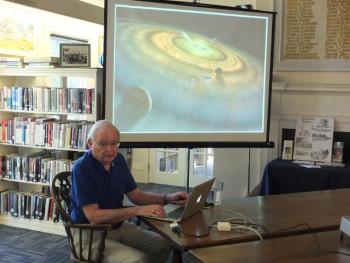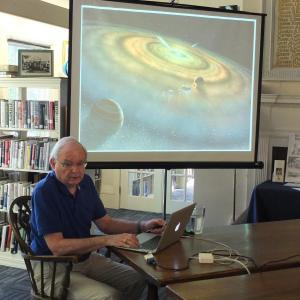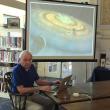Southport resident discusses his role in 1969 moon landing
On July 20, 1969, Robert Stengel joined millions of people watching astronaut Neil Armstrong take that “one small step for man, one giant leap for mankind” in becoming the first man on the moon. But unlike millions of people, Stengel played a role in getting Apollo 11 into space. Stengel was part of the team developing the technology for manned space travel. He worked on the computer code for steering the module’s 16 rockets.
Stengel is a now a professor of mechanical and aerospace engineering at Princeton University. He is also a Southport summer resident, and on Aug. 14 at Boothbay Harbor Memorial Library, he discussed the 50th anniversary of the Apollo moon landing. Stengel spent 90 minutes telling 30 guests about the history of space exploration and how it culminated with the first man setting foot on the moon.
From 1968 to 1973, Stengel was the Apollo project’s lunar module principal designer for manual control at Draper Laboratory in Cambridge, Massachusetts. He began his presentation stating man has always been fascinated with going to the moon, and he provided examples of stories through the years by authors Jules Verne and Cyrano de Bergerac. He also recounted the history of the rocket as a major impetus for space travel. He explained that American inventor Robert Goddard’s research on liquid-fueled rockets was the major impetus in the technology. Stengel explained the U.S. government didn’t pay much attention to Goddard’s work in the 1920s and 1930s, but Nazi Germany did. The Germans used his research to develop a V-2 rocket, the forerunner to spaceships the U.S. and the Soviet Union developed in the 1950s and 1960s.
Following World War II, the German rocket-developing teams were split between the U.S. and the Soviet Union, and the space race was on. The Soviet Union took an early lead. On Oct. 4, 1957, the Soviets launched Sputnik into orbit. The Soviets followed this by sending a dog into outer space in October 1958. Soviets continued their dominance on April 4, 1961 sending the first man into space. Conversely, the American space program struggled. The U.S.’s first attempt to launch a satellite crashed in October 1957, two seconds after the rocket lost thrust.
The Cold War provided huge motivation for the manned space race to the Moon,” he said. “Congress would’ve been slow to fund the Apollo program, if at all, without the geopolitical pressure to demonstrate technological superiority over the Soviet Union.”
But the U.S. program eventually caught up, and successfully placed satellites and manned space flights into orbit. By 1969, the two rivals were both focused on landing on the moon. The Soviets planned on landing a space ship on the Moon, but the U.S. had a more ambitious plan of landing a man on the Moon, and having him safely return to Earth.. Both space programs had planned to do it in July 1969. On July 3, the Soviets had a failed test mission, followed on July 13 by a failed launch. On July 16, NASA successfully launched Apollo 11 into space with Armstrong and fellow astronauts Michael Collins and Buzz Aldrin. On July 20, the crew landed the Apollo lunar module Eagle on the moon’s surface, and spent 21 hours collecting soil and rock samples. On July 24, Apollo 11 splashed down in the Pacific Ocean with all three astronauts safely returning home.
Stengel watched the moon landing from a laboratory conference room in Cambridge, Massachusetts. Stengel payed close attention to how Armstrong piloted the landing using the technology Stengel helped develop. He remembers a comment Armstrong made. “As anticipated, quick and responsive,” he said.
Advances in computer technology aided NASA’s efforts in putting a man on the moon. Stengel compared the first integrated computer used by NASA to a 2010 i-Phone. “Sixteen bits to 64 bits. A million times more storage. 1,300 times faster. The NASA computer also weighed 70 pounds and connected to another unit weighing 70 pounds,” he said.
Stengel described the space program’s legacy as being long on technological advances and scientific discoveries. NASA’s technological achievements resulted in modern airplanes using digital flight computers and in developing CT scans (computerized tomography) or CAT scans. “There has been huge scientific discoveries ranging from the Space Shuttle, robotic space probes orbiting Earth, Solar Space Station and beyond,” he said.
Stengel believes future space exploration will result in more scientific discoveries.
“The original intent wasn’t for science. It was to beat the Russians into space,” he said. “We never would’ve gone to space if the Russians hadn’t launched Sputnik.”
Stengel reported more nations have joined the Russians and Americans in developing space programs. An Israeli privately funded mission ended with a crash into the orb April 11. The Chinese have also made strides into space. A Chinese craft was the first to land on the moon’s far side. Stengel believes this gives scientists a better view of the universe. He also briefly discussed private space programs financed by Jeff Bezos and Elon Musk.
Stengel said the U.S. is considering more trips to the moon beginning with unmanned crafts and eventually manned visits. He said the greatest legacy of the moon landing was the confidence it gave Americans in solving problems. “If we can put a man on the moon, then why can’t we ...,” he said.
Event Date
Address
United States


























